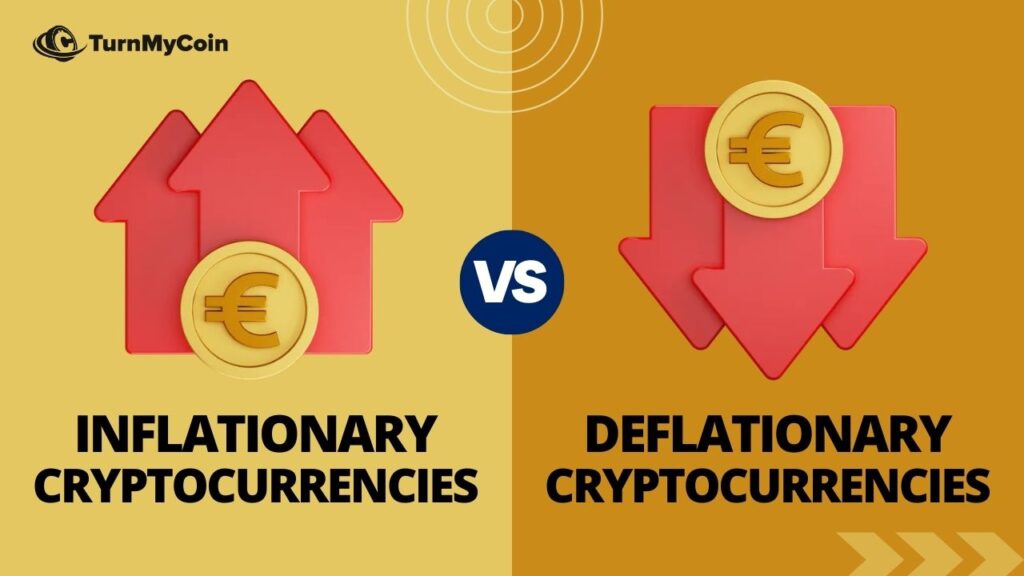Last updated on January 19th, 2024 at 06:46 am

Inflation is a major concern for the economy, particularly in the United States where the inflation rate is currently estimated at 8.5% for 2022. This is a significant increase from the 7.0% rate in 2021. This rise in inflation puts pressure on stagnant wages and causes prices to increase. As a result, the debate on inflationary & deflationary cryptocurrencies has been gaining traction. Many individuals see cryptocurrencies as a potential solution for hedging against inflation. However, it’s important to note that cryptocurrencies can also be classified as either inflationary & deflationary cryptocurrencies.
So, will they truly help combat inflation? Inflationary cryptocurrencies, such as Bitcoin, increase the supply of currency over time through a process called mining. Miners solve complex mathematical puzzles to validate transactions and are rewarded with new Bitcoins. This process continues until a total of 21 million Bitcoins have been mined. At which point the issuance of new Bitcoins will stop. On the other hand, deflationary cryptocurrencies have a built-in mechanism that reduces the supply of currency over time.
For example, a inflationary & deflationary cryptocurrencies may be designed to automatically burn a certain percentage of tokens every time a transaction is made. This reduces the overall supply of the currency and increases the value of the remaining tokens. Inflationary cryptocurrencies are often seen as a hedge against inflation and are often used as a store of value. Deflationary cryptocurrencies, on the other hand, are seen as a good investment opportunity. As their value is expected to increase over time as the supply decreases.
Table of Contents
What is Inflation vs Deflation?
Inflation and deflation are economic concepts that refer to the rate of change in prices of goods and services. It refers to a sustained increase in the overall price level of an economy. While deflation refers to a sustained decrease in the overall price level. Inflation is measured by the Consumer Price Index (CPI) and is commonly reported as an annual percentage increase or decrease. A positive inflation rate means that prices are rising, while a negative inflation rate means that prices are falling.
When inflation is high, the purchasing power of money decreases and people’s standard of living can be affected. High inflation can make it difficult for businesses to plan for the future and for individuals to save for retirement. On the other hand, deflation can be harmful to an economy as well. Deflation can lead to a decrease in economic activity as consumers delay purchases in anticipation of lower prices. Deflation can also lead to an increase in debt as the real value of debt increases. Inflation and deflation are two important economic concepts that can have a significant impact on an economy. Understanding the differences between them can help individuals and businesses make informed decisions.
Inflationary cryptocurrencies
Inflationary cryptocurrencies are digital currencies that have an unlimited or increasing supply. This is done through a process called mining where miners solve complex mathematical puzzles to validate transactions and are rewarded with new coins. As a result, the total supply of the currency increases over time. Bitcoin, for example, has a finite supply of 21 million coins, however, the reward for each block mined is halved every 210,000 blocks.

This means that the rate at which new Bitcoins are created will decrease over time, but it will never reach zero. Inflationary cryptocurrencies are often viewed as a hedge against inflation and are used as a store of value. Because the supply of the currency is increasing, its purchasing power is expected to decrease over time. However, the value of the currency can also increase if demand for it is greater than the rate of inflation. Inflationary cryptocurrencies can also be used for everyday transactions as they can be easily exchanged for goods and services. However, it’s important to note that the monetary policy of a cryptocurrency can have a significant impact on its value and how it’s used.
Pros of inflationary cryptocurrencies:
Inflationary cryptocurrencies are often viewed as a hedge against inflation. As the supply of the currency increases over time, its purchasing power is expected to decrease, which makes it a good store of value.
They can also be used for everyday transactions as they can be easily exchanged for goods and services.
Inflationary cryptocurrencies can also increase in value if demand for them is greater than the rate of inflation.
Cons of inflationary cryptocurrencies:
As the supply of the currency increases over time, the value of the currency may decrease, which can make it a risky investment.
The monetary policy of a cryptocurrency can have a significant impact on its value and how it’s used. It’s important to understand the monetary policy of the specific cryptocurrency in question before making any investment decisions.
In some cases, a high inflation rate in a cryptocurrency may lead to a lack of trust and a lack of adoption
Deflationary cryptocurrencies
Deflationary cryptocurrencies are digital currencies that have a built-in mechanism to reduce the supply of the currency over time. This is done through a process called burning, where a certain percentage of coins are destroyed every time a transaction is made. As a result, the total supply of the currency decreases over time.

For example, a cryptocurrency may be designed to automatically burn 1% of tokens every time a transaction is made. This reduces the overall supply of the currency and increases the value of the remaining tokens.
Deflationary cryptocurrencies are often viewed as a good investment opportunity as their value is expected to increase over time as the supply decreases. They are also considered as a store of value as the purchasing power of the currency increases over time as the supply decreases.
However, it’s important to note that deflationary cryptocurrencies may not be suitable for everyday transactions as the value of the currency increases over time. This might make it difficult for merchants to price their goods and services.
Pros of deflationary cryptocurrencies:
Deflationary cryptocurrencies are designed to decrease the supply of the currency over time, which is expected to increase the value of the remaining coins. This makes them a good investment opportunity as the value of the currency is expected to increase over time.
As the purchasing power of the currency increases over time as the supply decreases, they are considered as a store of value.
Deflationary cryptocurrencies may also benefit merchants as the value of the currency increases over time, it may be easier to price goods and services.
Cons of deflationary cryptocurrencies:
Deflationary cryptocurrencies may not be suitable for everyday transactions as the value of the currency increases over time. This can make it difficult for merchants to price their goods and services.
The monetary policy of a cryptocurrency can have a significant impact on its value and how it’s used. It’s important to understand the monetary policy of the specific cryptocurrency in question before making any investment decisions.
In some cases, a high deflation rate in a cryptocurrency may lead to a lack of trust and a lack of adoption
Factors behind Economics of Inflationary & Deflationary Cryptocurrencies

Maximum Supply:
The maximum supply of a cryptocurrency refers to the total number of coins that will ever exist. This limit is set by the cryptocurrency’s protocol and cannot be exceeded. It’s an important factor in determining the economic principles behind a cryptocurrency. For example, if a cryptocurrency has a maximum supply of 21 million, as in the case of Bitcoin, it is considered as deflationary.
Circulating Supply:
The circulating supply of a cryptocurrency refers to the number of coins that are currently in circulation and available for trading. This number can change as new coins are mined or created and as others are lost or destroyed. The circulating supply is an important factor in determining the current and future value of a cryptocurrency.
Total Supply:
The total supply of a cryptocurrency refers to the number of coins in circulation plus any that are locked or reserved. It includes the coins that have been mined but are not yet available for trading. The total supply is an important factor in determining the economic principles behind a cryptocurrency. For example, if a cryptocurrency has a total supply of 21 million, as in the case of Bitcoin, it is considered as deflationary.
Basis for Inflationary & Deflationary Cryptocurrencies Comparison
When comparing inflationary & deflationary cryptocurrencies, it’s essential to consider the following factors:

Monetary policy:
The monetary policy of a cryptocurrency can have a significant impact on its value and how it’s used. Inflationary cryptocurrencies often have a monetary policy that reflects a hedge against inflation, while deflationary cryptocurrencies have a monetary policy that aims to increase the purchasing power of the currency.
Supply:
The supply of an inflationary cryptocurrency increases over time, which is expected to decrease the purchasing power of the currency. On the other hand, the supply of a deflationary cryptocurrency decreases over time, which is expected to increase the purchasing power of the currency.
Adoption:
The rate of adoption of a inflationary & deflationary cryptocurrencies can also play a crucial role in determining its value. A high rate of adoption can lead to an increase in demand and, subsequently, an increase in value.
Transparency:
The transparency of the cryptocurrency’s development and governance can also be a significant factor to consider. A transparent and open development process can help build trust in the currency and increase its adoption.
Volatility:
Cryptocurrency markets are known for their volatility, and it’s essential to consider how a currency’s volatility may impact its value and adoption.
Ultimately, the basis for comparison between inflationary and deflationary cryptocurrencies will depend on the individual’s investment goals and risk tolerance. It’s essential to conduct thorough research and to understand the economic principles behind each currency before making any investment decisions.
Inflationary & Deflationary Cryptocurrencies Comparison:
Inflationary cryptocurrencies are designed to increase the supply of coins over time, with the expectation that this will decrease the purchasing power of the currency. This is in contrast to deflationary cryptocurrencies. Which are designed to decrease the supply of coins over time, with the expectation that this will increase the purchasing power of the currency.

One key difference between inflationary & deflationary cryptocurrencies is their monetary policy. Inflationary cryptocurrencies often have a monetary policy that reflects a hedge against inflation, while deflationary cryptocurrencies have a monetary policy that aims to increase the purchasing power of the currency.
Another important factor to consider is the rate of adoption. A high rate of adoption can lead to an increase in demand and, subsequently, an increase in value. Inflationary cryptocurrencies may have a higher rate of adoption due to their ability to hedge against inflation, while deflationary cryptocurrencies may have a lower rate of adoption due to the expectation of decreasing purchasing power.
Transparency is also an important factor to consider when comparing inflationary and deflationary cryptocurrencies. A transparent and open development process can help build trust in the currency and increase its adoption.
Additionally, volatility is a significant factor to consider when comparing inflationary and deflationary cryptocurrencies. inflationary & deflationary cryptocurrencies markets are known for their volatility . It’s essential to consider how a currency’s volatility may impact its value and adoption.
Conclusion
“To conclude, inflationary & deflationary cryptocurrencies differ in their design approaches to digital currency. Bitcoin, an example of an inflationary cryptocurrency, maintains a steady rate of inflation, while Ethereum, an example of a deflationary cryptocurrency, plans to gradually decrease its available supply. Both strategies have advantages and disadvantages, and the success of a inflationary & deflationary cryptocurrencies depends on factors like adoption, network effects, and the general market sentiment. Each individual investor must evaluate the potential risks and rewards of these models and decide which type of cryptocurrency aligns with their investment goals.”